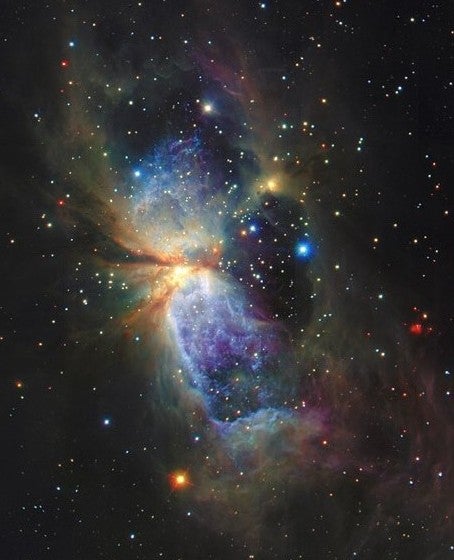In order for a rare, massive star to form inside an interstellar cloud of gas and dust, small “helper” stars about the size of the Sun must first set the stage, according to a new theory proposed by astrophysicists at the University of California, Berkeley, and Princeton University.
Massive stars between 10 and 150 times the mass of the Sun are few in number but produce the bulk of the heavy elements in a galaxy when they explode in supernovaes. Their extreme brightness makes them signposts of star formation in distant galaxies.
Astrophysicist Christopher F. McKee, professor of physics and astronomy at UC Berkeley, and Mark R. Krumholz, a Hubble postdoctoral fellow in the Department of Astrophysical Sciences at Princeton, have been modeling the formation of these stars for nearly 10 years. Recently, they looked at the conditions inside cold clouds of molecular hydrogen that favor formation of massive stars over low-mass stars like the Sun.
In a report this week in Nature, Krumholz and McKee argue that early formation of a few low-mass stars in a cloud paves the way for later formation of a stellar big brother instead of fragmentation of the cloud into a hundred smaller clouds, which would produce only low-mass siblings.
“It’s only the formation of these low-mass stars that heats up the cloud enough to cut off the fragmentation,” McKee says. “It is as if the cold molecular cloud starts on the process of making low-mass stars but then, because of heating, that fragmentation is stopped and the rest of the gas goes into one large star.”
“What it comes down to is that if a cloud is cold, it tends to break up into many small pieces that become low-mass stars,” adds Krumholz, who recently accepted a faculty position with the astronomy department at UC Santa Cruz. “As the cloud gets warmer, though, it can make bigger and bigger objects.”
The cloud temperatures are still cold, however. A typical interstellar hydrogen cloud is 10-20° C above absolute zero (10-20° K, or about -430° F), while low-mass stars can heat the cloud to double or triple this temperature. To stop the entire cloud from collapsing, the temperature would have to increase to many hundreds of degrees above absolute zero, McKee says.
According to Krumholz, each small star within a hydrogen cloud has a zone of influence where it warms up the gas and prevents it from collapsing into small fragments. In low-density clouds, each zone of influence is small and contains very little mass, so this effect is unimportant.
As the density increases, however, the gas and small stars get packed closer and closer together. Eventually, says Krumholz, the zones of influence of the few low-mass stars encompass the entire cloud, preventing the cloud from fragmenting and forcing it to collapse to make a massive star.
McKee notes that this collapse occurs within an even larger interstellar cloud that may contain more than a million times the mass of the Sun. Therefore, as in our galaxy’s Orion Nebula, many massive stars may be forming simultaneously inside a giant molecular cloud.
The density above which massive stars can form is about a million hydrogen molecules per cubic centimeter, which is a very extreme vacuum on Earth, he says, but nevertheless dense enough to collapse into a massive star over hundreds of thousands of years. The particle density in Earth’s atmosphere is 10 trillion times greater.
According to McKee, one implication of the density limitation is that in the outer reaches of galaxies, where the density may not reach this threshold in a sufficiently large region of space, low-mass stars may be forming in the absence of any massive stars. Because we can see only the big, bright stars from Earth, he says, astronomers may be underestimating the amount of star formation going on in distant galaxies.
“In fact, there may be many stars forming in the outer reaches of distant galaxies, just not the bright ones we can see,” McKee says. “Star formation could be occurring that is essentially invisible.”
He notes that a recent satellite collecting ultraviolet light from distant galaxies has seen evidence of star formation in the very outer regions of galaxies, and that this may confirm their prediction.










